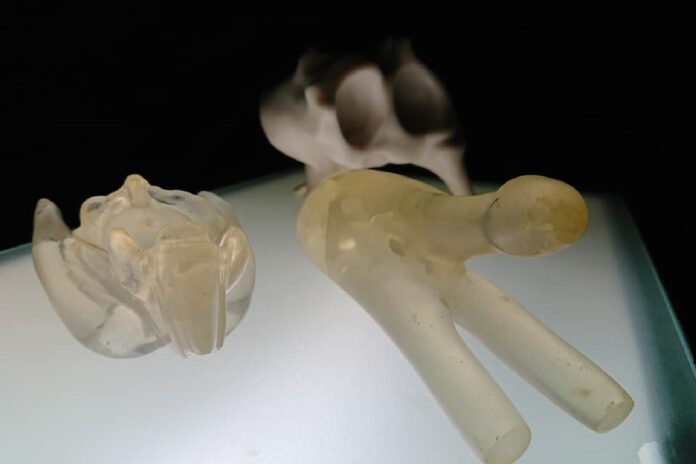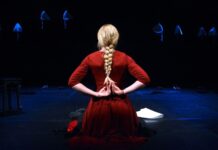The Mashrabia Gallery in Cairo presented Sherif El Azma‘s works for the first time with the exhibition “Belly of a mountain: Offerings and Plaques (2014-2020)”.
Sherif El Azma, biography
Born in England (Manchester) in 1975, he graduated from the Surrey Institute of Art and Design in 1997.
He chose Egypt to live and work following the origins of his family and settled in Fustat in the old part of the city of Cairo. From 1997 to 2010 he was actively involved in the production of experimental films and multimedia videos always related to his obsession with the contrast (or dialogue) between historical ritual objects and industrial leveling.
Since 2014 his research has focused on sculptures and objects that suggest distant deities, imaginary modular symbolic elements or others that never existed.
These will be the protagonists of the story that is the basis of each of his projects.
The exhibition “Belly of a mountain”, Sherif El Azma
In the exhibition “Belly of a mountain” the artist presents works in progress he designed to investigate forms, historical materials and reinterpretations by sing a symbolic language aiming at creating a hypothetical narrative full of possible discussions. This complex exhibition includes the production of sculptures, texts, photographic and multimedia works capable of representing various historical, mythological and fictional concepts through different kinds of media.
Sherif El Azma’s research gives way to contemporary forms for which he uses innovative materials. They are shapes that are still inspired by tradition and history.
“Belly of a mountain“ exhibition develops in four areas.
The trays
There are “The Trays” which represent the offer to existential awakening and to values that bring new and infinite narratives where symbols are deconstructed. He does this by imitating a ritual of repetitive actions that reinterpret space in a negative and positive way. Others simulate the ancient Greco-Roman language such as those found in Egyptian museums to suggest an inevitable but acute contemporary manipulation.
Offerings and plaques
Another area is entitled “Offerings and Plaques”. For them the artist was inspired by the period of the ancient Romans where the plaque conveyed a text with political, social or funerary meanings. So a stone that was inserted into the wall and was part of the construction itself. But Roman plaques did not always include texts. In different periods of Roman civilisation we find plates with hieroglyphics united over the centuries by a common lexicon. Sherif El Azma reinvents this ancient language using modern materials and creating a dialogue that introduces the possibility of emotion.
The order of forms
The area “The order of forms” consists of small sculptures based on an intense period of study and experimentation with different materials and also an interest in the Egyptian tradition, for esotericism and alchemy.
Bronze monuments, in progress
The fourth area is titled “Bronze monuments, in progress”. Residues of casting materials that become primary substance and produce free forms in a deliberately imageable language.
The Mashrabia Contemporary Art Gallery
The Masharabia Contemporary Art Gallery is considered a historical reality in Cairo having been founded in the mid-1970s. Located in the central district of the city, since 1990, under the direction of Stefania Angarino, it has become the reference point of contemporary art in Egypt. The gallery plays an important role in the discovery of emerging artists and also in the promotion of those already established.
Mostra dell’artista inglese al Cairo
La Galleria Mashrabia Gallery del Cairo ha presentato per la prima volta le opere dell’artista Sherif El Azma nella mostra “Belly of a mountain: Offerings and Plaques (2014-2020)”.
Sherif El Azma, biografia
Nato in Inghilterra (Manchester) nel 1975, si laurea al Surrey Institute of Art and Design nel 1997. Sceglie l’Egitto per vivere e lavorare seguendo le origini della sua famiglia e s’installa a Fustat nella parte vecchia del Cairo. Dal 1997 al 2010 è stato attivamente impegnato nella realizzazione di film sperimentali e anche di video multimediali sempre relazionati alla sua ossessione per il contrasto (o dialogo) tra oggetti storici rituali e il livellamento industriale. Dal 2014 la sua ricerca si concentra su sculture e oggetti che suggeriscono lontane deità, elementi simbolici modulari immaginari o mai esistiti.
Questi saranno i protagonisti del racconto che sta alla base di ogni suo progetto.
La mostra “Belly of a mountain”, Sherif El Azma
Nella mostra “Belly of a mountain” l’artista presenta opere in divenire atte a investigare forme, materiali storici e rivisitazioni usando un linguaggio simbolico che ha lo scopo di creare un’ipotetica narrazione gravida di possibili discussioni.
Questa complessa mostra include la produzione di lavori di scultura, testuali, fotografici e multimediali in grado di rappresentare i vari concetti storici, mitologici e di fiction attraverso diversi media.
La cifra che caratterizza l’arte di Sherif El Azma è la ricerca di forme decisamente contemporanee per le quali utilizza materiali innovativi e che pure si ispirano alla tradizione e alla storia.
La mostra “Belly of a Mountain” si sviluppa in quattro aree.
I vassoi
Ci sono “the Trays” (i Vassoi) che rappresentano l’offerta al risveglio esistenziale e ai valori portatori di nuove e infinite narrazioni dove i simboli sono decostruiti. Egli fa questo, imitando un rituale di azioni ripetitive che reinterpretano in modo negativo e positivo lo spazio. Altri simulano l’antico linguaggio greco-romano come quelli che si trovano nei musei egiziani a suggerire un’inevitabile ma acuta manipolazione contemporanea.
Le targhe
Un’altra area ha per titolo “The plaques” (le Targhe). Per esse l’artista si è ispirato al periodo degli antichi romani dove la targa veicolava un testo con significati politici, sociali o funerari. Quindi una pietra che veniva inserita nel muro e faceva parte della costruzione in sé. Ma non sempre le targhe romane includevano un testo. In diverse epoche della civiltà romana ritroviamo targhe con geroglifici accomunati durante i secoli da un lessico comune.
Sherif El Azma reinventa questo antico linguaggio utilizzando materiali moderni e creando un dialogo che introduce la possibilità dell’emozione.
L’ordine delle forme
L’area “ The order of forms” (L’ordine delle forme) consiste in piccole sculture dovute a un intenso periodo di studio e sperimentazione di diversi materiali e anche all’interesse per la tradizione egiziana, per l’esoterismo e l’alchimia.
Monumenti in bronzo, in progress
La quarta area si intitola “Monuments in bronze, in progress” (Monumenti in bronzo, in progress). Residui di materiali di colata che diventano sostanza primaria e producono forme libere in un linguaggio volutamente figurabile.
Galleria d’Arte Contemporanea Mashrabia
La Galleria d’Arte Contemporanea Mashrabia è considerata una realtà storica a Il Cairo essendo stata fondata a metà degli anni ’70. Situata nel quartiere centrale della città, dal 1990, con la direzione di Stefania Angarino, diventa il punto di riferimento dell’arte contemporanea in Egitto. La galleria gioca un ruolo importante nella scoperta di artisti emergenti e anche nella promozione di quelli già affermati.
Leggi anche: MACA, il museo cosmopolita in Uruguay








